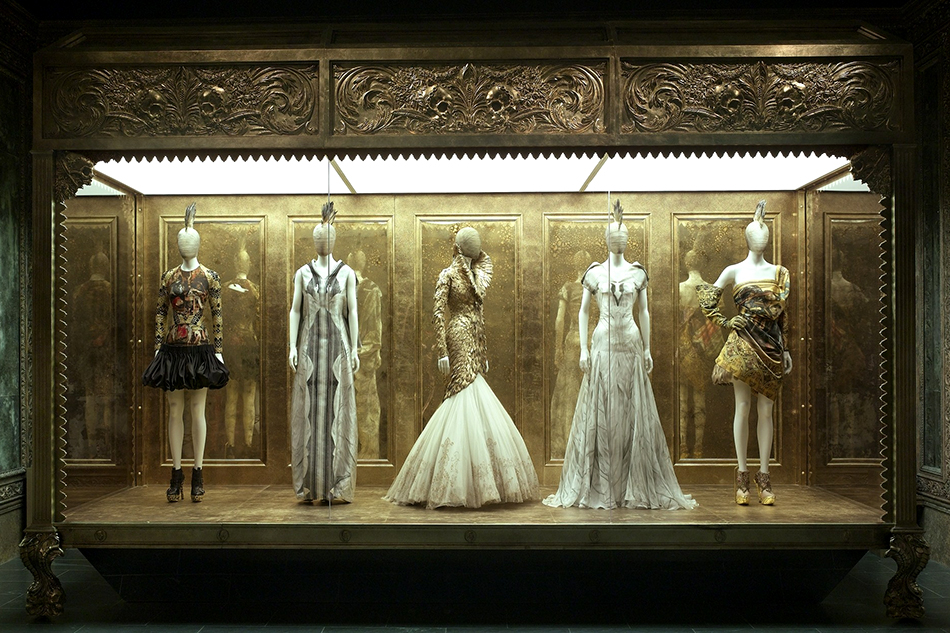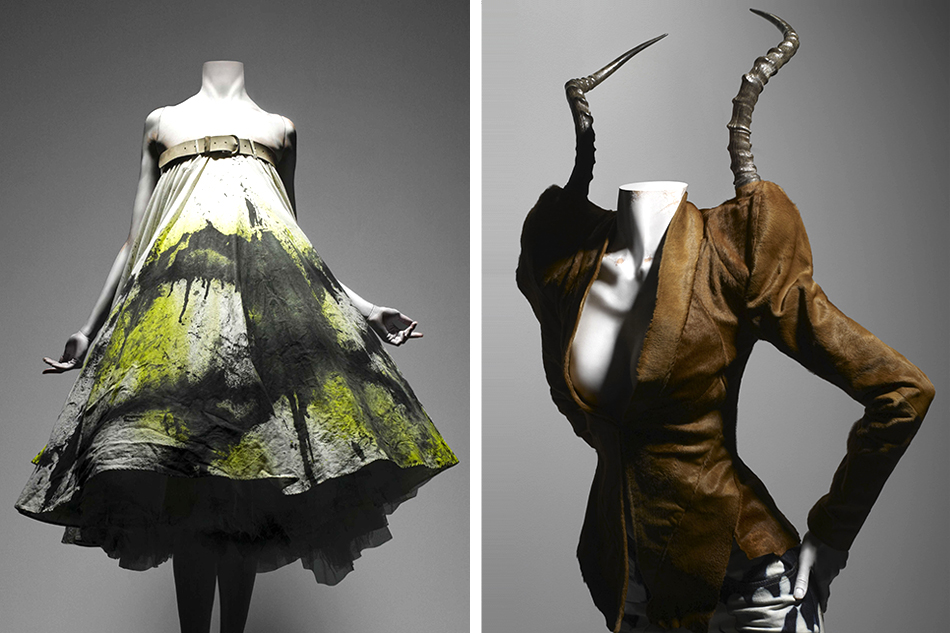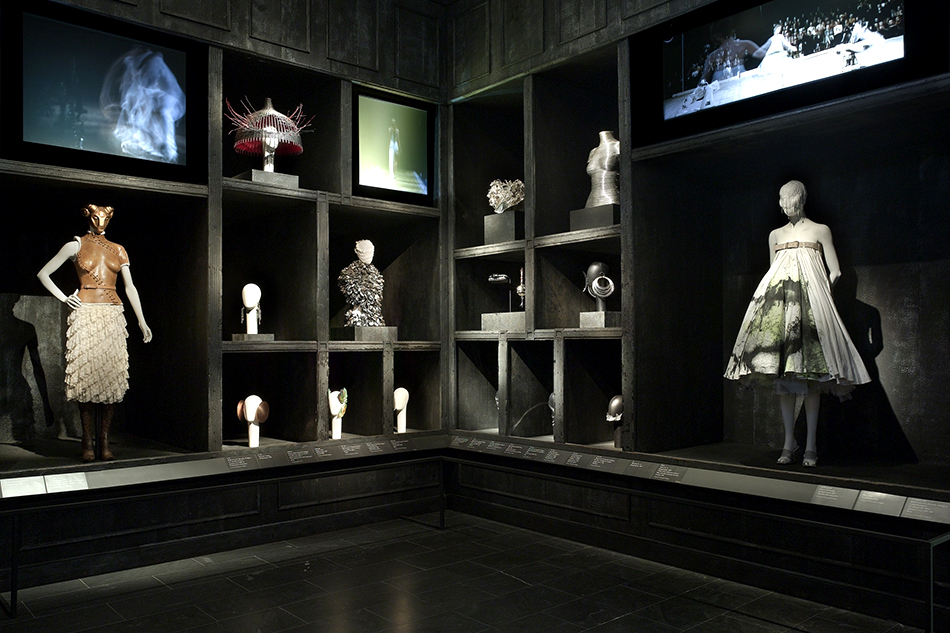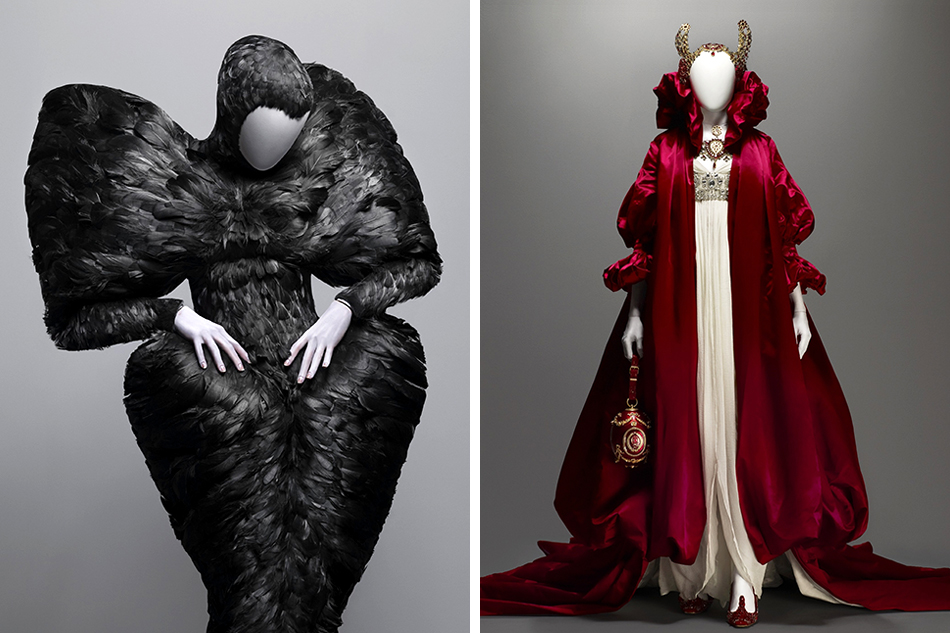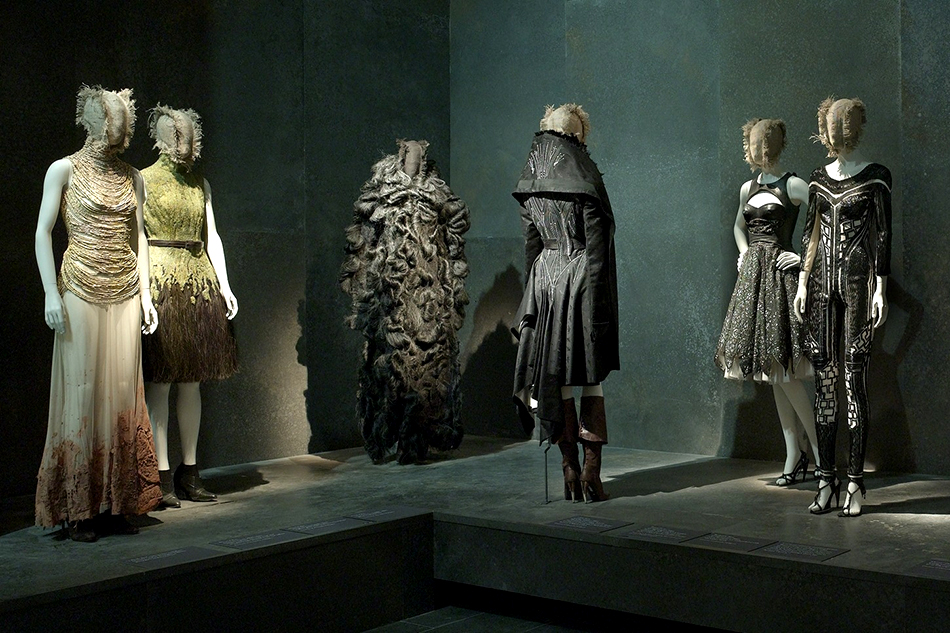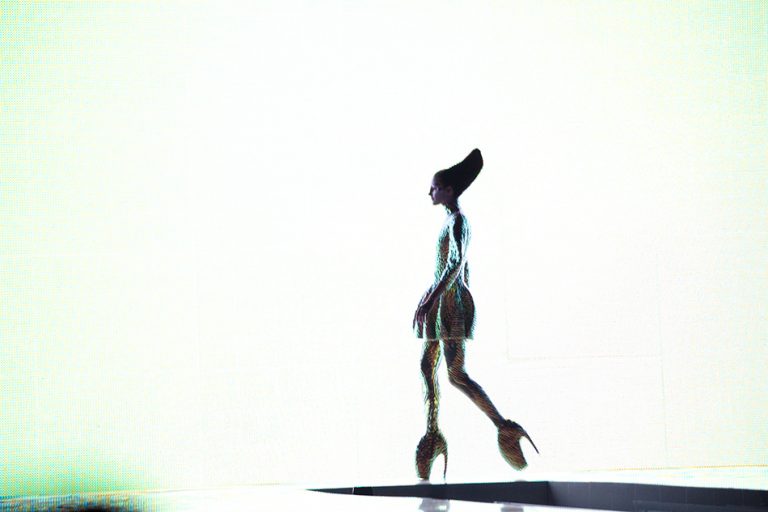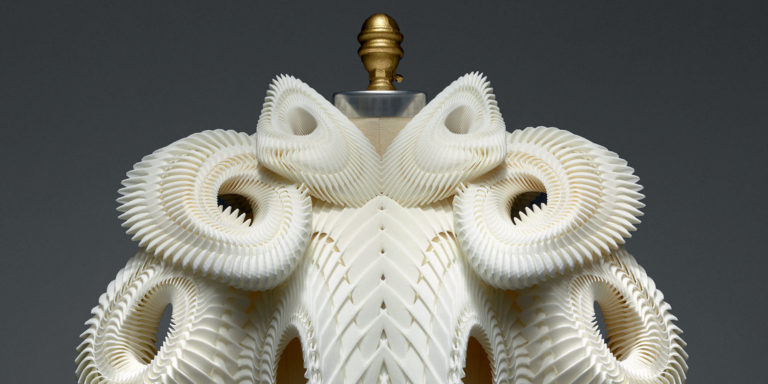
May 18, 2011Alexander McQueen “believed that fashion should touch you emotionally,” explains Andrew Bolton, seen here, curator of “Savage Beauty,” the exhibition devoted to the late British designer at the Metropolitan Museum of Art’s Costume Institute, in New York. Top: A look from McQueen’s Autumn/Winter 2010 collection. All fashion photographs by Sølve Sundsbø, from the exhibition catalogue
It is a few weeks before the May 4 opening of “Alexander McQueen: Savage Beauty,” the current 2011 Costume Institute exhibition at the Metropolitan Museum of Art that runs through July 31. I am somewhere deep beneath its venerable galleries, in a small, windowless room, having walked through a black cavern, an apparent storage space for bare mannequins and shrouded forms. A life-size wax effigy of Diana Vreeland with a distinct, slightly unnerving forward lean, holds sway over a harshly lit conference table at which I am sitting opposite Andrew Bolton, curator in the Costume Institute and the man with the “bittersweet” task, as he puts it, of bringing British fashion designer Alexander McQueen back to life.
It is one helluva charge for a museum, let alone an individual, to be the first to do justice to the brilliant, almost hallucinatory-slash-incandescent body of art McQueen left behind, an awe-inspiring output created during just 19 years. Visitors to the exhibit are not only looking to celebrate the man’s breathtaking creative force, they will also be seeking an answer (or comfort, perhaps) as to why he extinguished it last year, committing suicide at age 40. Despite the show’s potential for gloom, and his having just met a midnight deadline the night before for the book accompanying it, Bolton, makes it clear that he rejoices in the idea of the exhibition as a resurrection of sorts, in no small measure due to his Catholic upbringing. “With a small ‘c’ but it is very much something you keep with you!,” he declares with a quick grin.
Dressed in khaki jeans, and with a lemon-yellow shirt and quasi-school tie, Bolton exudes a brainy demeanor. A youthful and bespectacled Lancashire Brit and a contemporary of McQueen, he engagingly admits that “even in my punk phase I looked like a Sloane. My style is fated to be at the nerd end of fashion!”

The Oyster dress, Spring/Summer 2003, one of the creations now wowing crowds at the Met’s “Alexander McQueen: Savage Beauty.”
Having studied social anthropology at the University of East Anglia, Bolton is fascinated by fashion as a manifestation of its cultural context, its psychological underpinnings as well as its wider impact on society. “It is not just about excellent craftsmanship,” he says. “It is about ideas, and emotions, transferred through clothing.” As a curator he could be talking about a painting rather than clothing. His is a mindset and point of view that certainly makes sense when speaking about McQueen, who justifiably considered himself an artist, stating unequivocally: “Fashion is just the medium.”
“What was incredible about McQueen is that he really believed in the power of the imagination; he was a Romantic in the Byronic way,” Bolton observes. “His themes were extremes: birth and death, nature versus technology, intuition opposed to rationalism. There was an anger within McQueen that fueled the tension between the positive and the negative, and that frisson was his creative energy. He believed that fashion should touch you emotionally. He felt that deeply, deeply, deeply.”
“McQueen took an authentically artistic approach,” Bolton continues. “He couldn’t start the fashions themselves until he had established the narrative. That is how important the runway show was to him. It was a venue to communicate ideas.”
Bolton similarly favors narrative, ascribing it to the English love of story. As a curator, however, his creativity is initially inspired by the fashions. “All my ideas and themes flow from seeing the objects up on the storyboard,” he says. “The object is a way in to larger-scale, more esoteric ideas and concepts. By using objects to tell a story — catch an audience — you can locate them within a wider cultural discourse, ground ideas in them.” Bolton has recently seen more fashion academics coming out of the art-school tradition to work in museums, which, he says, “is great, because it is topsy-turvy to have the theory first and then find the object to fit it.”
“McQueen couldn’t start the fashions themselves until he had established the narrative. That is how important the runway show was to him. It was an avenue to communicate ideas.”

A jacket, Autumn/Winter 2010, by Alexander McQueen, who, according to Bolton, “took an authentically artistic approach” to every garment he designed.
Bolton grew up in a close-knit family, engaged in ideas, current affairs and politics, often discussed at the local pub. Before coming into his own through “meeting like-minded people at Uni,” Bolton says he indulged his impressionable teens in the heady post-punk New Wave era, circa 1980. His hero was Gary Numan not Cecil Beaton: the androgynous, synthesizer-playing purveyor of angst-ridden music and lyrics rather than the fashion aesthete and dandy with a camera. He admits to an element of “armchair culture. I experienced a lot through my bedroom and my record player!” But he is being somewhat disingenuous since he also admits to frequenting the legendary Hacienda nightclub in Manchester, the spiritual home of acid house and rave music.
“Music was something I was particularly interested in as a child because it was so connected to fashion, particularly the New Romantics,” he explains. “Buffalo came to the fore, Vivienne Westwood’s second collection. It was also when provocative style magazines like The Face, Arena and i-D came into existence. They brought music, film, fashion and popular youth counter culture together for the first time. English fashion, in general, is about street style and its innate idea of anarchy: anti-establishment, anti-monarchy. I think it stems from English society with its class system, that terrier mentality of needing to shake things up.”
McQueen certainly shook up fashion; he was a born Rottweiler. His upbringing on a council estate in north London played a part, but his family was close and supportive, not dysfunctional. He was proud of his Scottish heritage: He was a defiant fashion warrior. His historical themes and shows — such as “Highland Rape,” 2002, which was inspired by England’s “rape of Scotland,” as McQueen called it — always invoked powerful reactions from his audience of fashion pros. These were “roller-coaster emotions; full of terror to full of wonder,” Bolton observes. “As McQueen said, ‘I want people to feel something, I want them to vomit.’ ”

The designer in his studio. Photo by Derek Santini
He got away with consistently courting controversy because that self-same audience was also in thrall to his masterful technical virtuosity. “His distinctive design vocabulary was established right from the start. His 1992 post-grad show had such a strength of mind and confidence in his capabilities,” Bolton affirms. “McQueen felt you have to know the rules before you can break them; you have to know how to construct before you deconstruct.” The designer acquired first-hand knowledge of the rules by apprenticing with such traditional London tailors as Gieves & Hawkes, becoming a razor-sharp cutter. “He combined the rigors of tailoring with the spontaneity of dressmaking,” Bolton continues. “Even with a jacket that had a very strong shoulder, he would collapse a lapel.” Always playing with the unexpected, even in his construction, McQueen advanced fashion, using his craft to create new silhouettes.
Bolton’s own professional journey toward “Savage Beauty” began at London’s Victoria & Albert Museum, in 1992, where he was a general curatorial assistant, gaining experience in various departments. He recalls it was an exciting time fashion-wise in London. “British designers were using fashion as a vehicle to explore concepts that touched our cultural anxieties and reflect them back to us,” he says, referencing McQueen and his contemporary, the conceptualist Hussein Chalayan, famous for his series of burka-clad models. “I thought the museum would be a stepping stone to a Ph.D.,” Bolton says, sounding surprised still, “but I loved that it was so involved in education, something I have always believed in. It seemed more real than academia, its impact broader, more democratic and accessible.” Plus, he loved all those objects, an essential curatorial character trait if not the essence.
Bolton was subsequently promoted to senior research fellow in contemporary fashion. “It ticked every box in terms of what I believed in. I love the sensibility of fashion, its democracy. I still cannot believe I have a career in something I love so much that it feels like a hobby!” At the time, the V&A was shaking off its dusty image and mounting groundbreaking exhibitions that married object-based research and cultural context. Bolton curated a number of shows himself, at both the V&A and the London College of Fashion. He took his controversial 2001 V&A exhibition, “Men in Skirts,” to New York the following year to inaugurate his appointment as associate curator in the Costume Institute.

A remarkably detailed piece from McQueen’s Voss collection, Spring/Summer 2001
Alongside curator in charge, Harold Koda, Bolton has presented 10 provocative shows, but “Savage Beauty” is much more than an exhibition; it is an immortalization, a breathtaking ode to a supernatural talent.
Two days before the exhibit opens, I am in another maze of black caverns for the preview, this time, one of adjoining galleries. The show is mesmerizingly intimate, dimly lit. Nothing is quite what it seems. Everything draws us in to tantalize and to transport us to another world: McQueen’s romantic imagination, his night, mirror opposite mirror, bombed planks, haunting music, a hologram of what appears to be a fairy angel (Kate Moss, on closer inspection), a sanctum of accessories, and it just keeps on coming.
Within each display, dressed and semi-dressed mannequins stand mute witness. The designs are so powerful, they speak for themselves to illuminate our thoughts. Nothing McQueen left behind can be taken for granted because it is clear this is his life story. His genius is treasonable. He dares us to find fault. It is clear that each talented individual who worked with Bolton on this show subsumed ego to reveal McQueen’s id.
Walking through the show, I recall Bolton sitting back in his chair when we first met, when all the fashions and objects now on view were but images on his storyboard. “You know,” he said then, “McQueen was once asked what he noticed in the streets when he walked around London, and he answered, ‘I notice the ugly things.’ Perfection didn’t interest him, or at least, the classical idea of beauty didn’t.”
McQueen must be having a good laugh up there, I think; he created undeniable beauty that savages the viewer. And in that tension lies Bolton’s clever sleight of curatorial hand. He has ensured that in death, as in life, McQueen continues to control our thoughts and emotions, a Romantic in perpetuity. It is a comfort and a joy.

